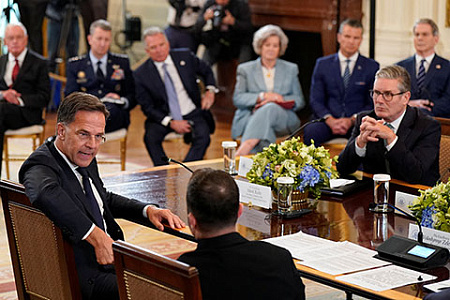
A new framework for Ukraine’s post-war security, involving the deployment of Western military forces, is being shaped in high-level discussions within NATO. This initiative, emerging from a recent diplomatic push by Donald Trump to end the conflict with Russia, would see troops from a “coalition of the willing” enter Ukraine. However, this force would pointedly not include American soldiers and is already facing significant rejections from major European allies.
The proposed security guarantees were a central topic at recent NATO meetings in Brussels, following a series of negotiations led by Trump. After meeting with Russian President Vladimir Putin in Alaska and later hosting Ukrainian President Volodymyr Zelenskyy and several European leaders, Trump outlined a path toward a peace agreement. A cornerstone of this plan is that Ukraine would officially abandon its ambitions to join NATO, a move presented as a major concession to Moscow, in exchange for alternative security assurances and a direct summit between Putin and Zelenskyy.
Under this plan, a contingent of approximately 30,000 troops from the “coalition of the willing” would be deployed to Ukraine, but only after a ceasefire is in effect. These forces would not be stationed on the front lines but would instead secure rear areas and help defend Ukrainian airspace. The United Kingdom and France have signaled their readiness to lead this effort, positioning themselves as the core of the potential deployment.
Despite the Anglo-French commitment, the coalition is showing signs of fracturing before it even forms. Citing a Bloomberg report, sources indicate that fewer than ten of the 33 nations theoretically involved are prepared to contribute troops. Significantly, Germany has unequivocally ruled out its participation, with its foreign minister stating that the German military is already overstretched with existing European security tasks. Poland has adopted the same stance, with its defense minister confirming that Warsaw will not send soldiers, further diminishing the size and scope of the proposed force.
The diplomatic path forward remains fraught with uncertainty. Moscow has given no public indication that it has agreed to a Putin-Zelenskyy summit, a critical step in Trump’s peace plan. Reports that the UK and EU might impose new sanctions on Russia if the meeting does not materialize could be counterproductive, as the Kremlin has historically resisted negotiations under pressure.
As a result, the security architecture for a post-war Ukraine appears to be shifting away from the collective strength of the NATO alliance. Instead, it relies on a smaller, more ad-hoc coalition led by London and Paris. While the European Union may offer certain commitments, as suggested by the European Council President, it lacks a unified army to provide the hard military guarantees Kyiv seeks, leaving the future of a stable and lasting peace in the region in question.
